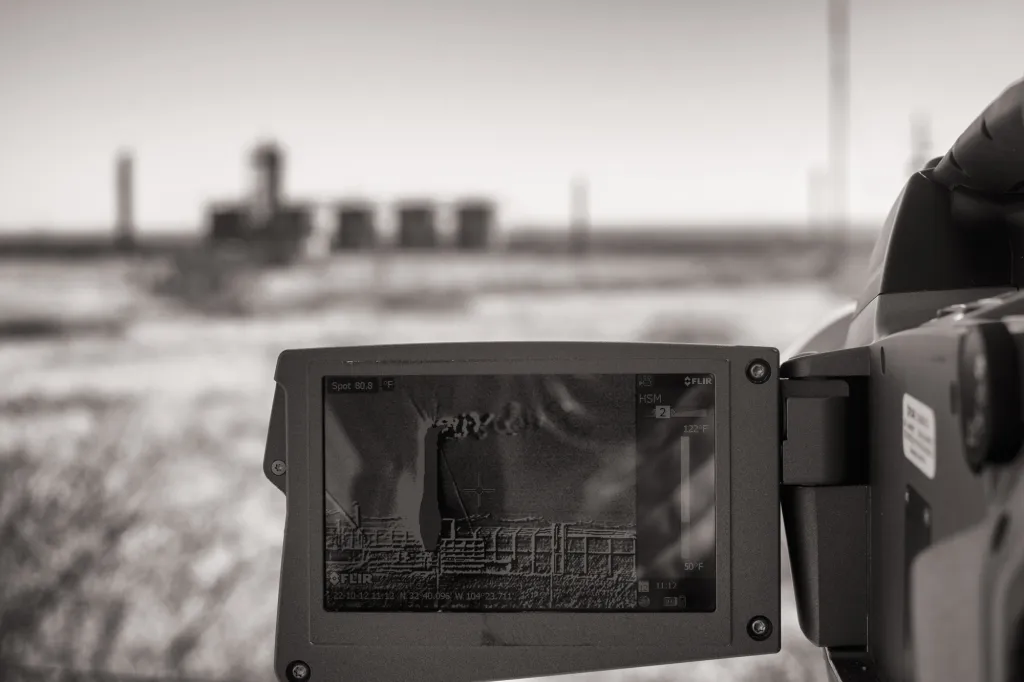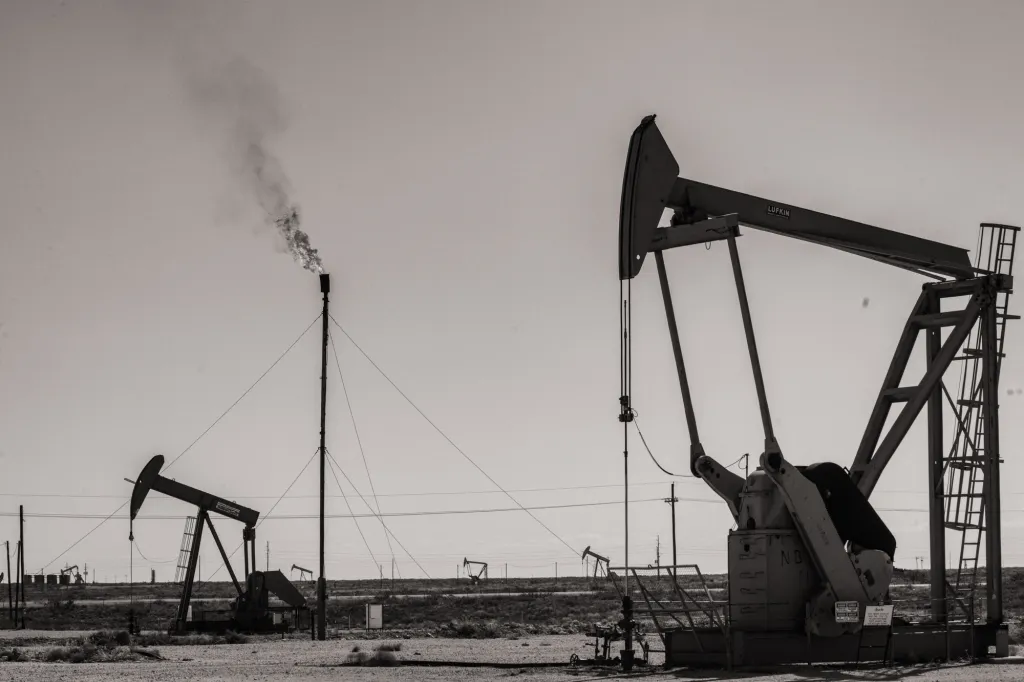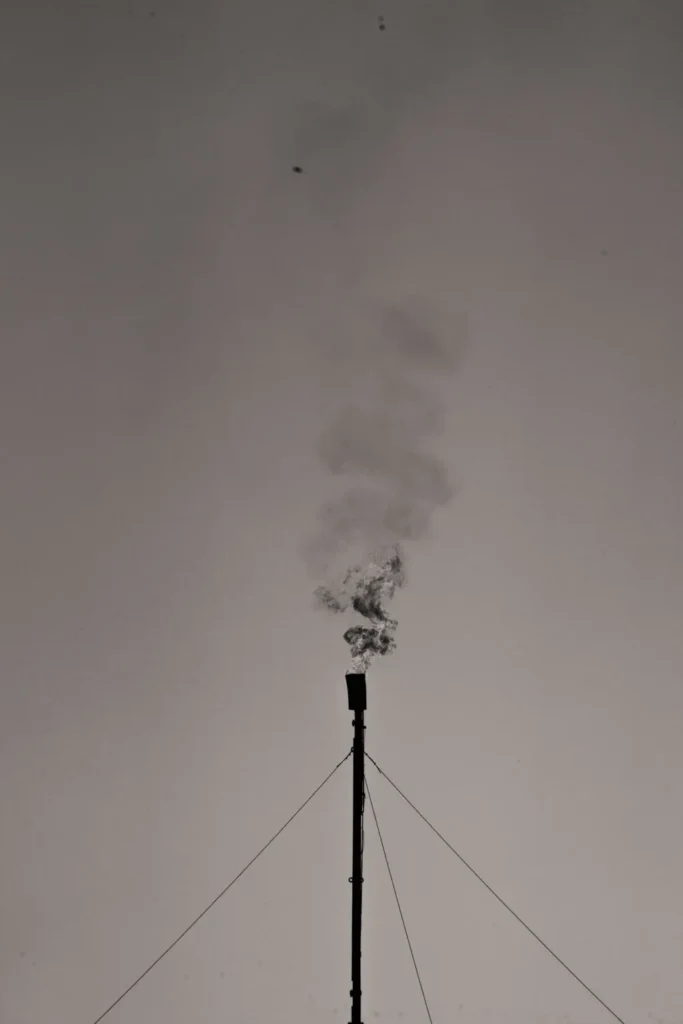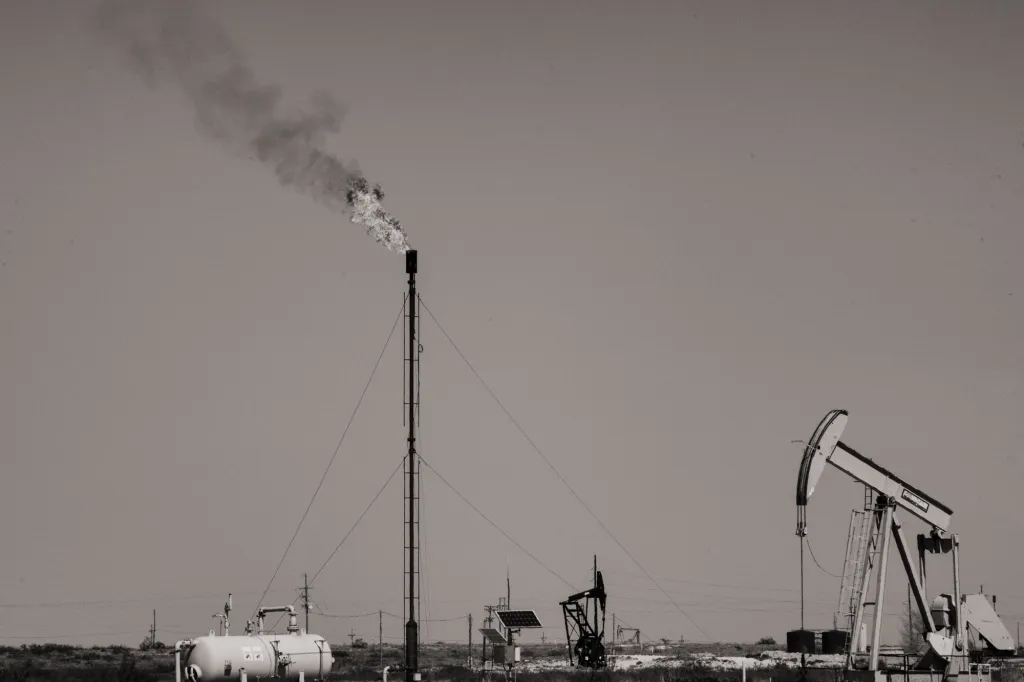By Lindsay Fendt/ Searchlight New Mexico
New Mexico’s tough new pollution rules rely on oil and gas operators to report their methane emissions. Can self-policing work?
ARTESIA, N.M. — To the naked eye, the oil storage tanks at the well site look normal. Then Charlie Barrett pulls out his specialized camera and trains the lens on a tall and narrow pipe used to vent or flare gases.
“There, it’s emitting,” he says, pointing out a clump of gray pixels on the view screen.
Barrett works as a field advocate for Earthworks, a Washington, D.C.-based environmental group working to end pollution from oil, gas and mining. He’s certified as a thermographer, trained to operate an infrared camera that can detect methane and other harmful gases.
On this day in late fall, he’s circling the rough roads that meander through the oil patches in the Permian Basin, one of the world’s most productive oil fields, which straddles southeastern New Mexico and western Texas.
At dozens of well sites, the camera reveals rippling clouds of methane spewing from tanks, pipes and vents. Thick clouds of gas flow from the base of one idle pump. Another leak of an unknown gas is visible from about a mile down the road — a tank surrounded by black smoke so thick and dark that Barrett doesn’t need the camera to see it. About a month earlier, a site somewhere to the southeast released so much methane that the International Space Station detected the 2-mile-long cloud from space.
It wasn’t always like this. Before ranchers and oil companies arrived, the Permian was part of the largest contiguous prairie in North America, full of shrubs and shortgrass and teeming with ground-dwelling birds, as Barrett, an ecologist by training, explains. But today, the oil pumpjacks are the only visible sign of movement, teetering back and forth like some new, otherworldly prairie species.
The sheer number of well sites in the Permian is staggering — about 31,000 active wells in New Mexico alone. In some areas, hundreds of pumpjacks stretch to the horizon, a fractional part of the pipes, hoses and tanks that pull an average of more than 1.6 million barrels of oil and 2 trillion cubic feet of natural gas from New Mexico’s depths each day. The oil and gas industry as a whole produces more than 50 percent of the state’s total greenhouse gas emissions.
In 2019, a climate change task force formed by Gov. Michelle Lujan Grisham urged state regulators to address these emissions from oil and gas equipment, which had been steadily rising since 2017. Curtailing these releases, the task force found, was crucial to meeting the state’s climate goals, which call for substantially reducing greenhouse gas emissions by 2030.

In response, the state’s environmental offices crafted ambitious new rules. One rule, from the state’s Oil Conservation Division, limits the amount of unwanted methane that operators can burn off (flare) or release directly into the air (vent). Another, from the New Mexico Environment Department, requires operators to replace leaky equipment, inspect their wells more often and promptly fix any leaks they discover. By 2026, operators will have to capture 98 percent of all the natural gas their operations produce by either selling or using it.
The rules are some of the strongest in the country, but there’s a catch: They rely on the industry to police itself and accurately report its own emissions. And out in the field, it’s clear that things are already slipping through the cracks.
With the help of Earthworks, Searchlight found 20 well sites that were releasing methane or other polluting gases in the Permian during a two-day tour near Artesia and Carlsbad. These observations were cross-checked with the monthly reports that operators must file with the Oil Conservation Division (OCD), to see if operators were reporting each venting and flaring incident, as required. Thirteen of the 20 reports for these facilities failed to show methane releases consistent with what was observed in the field. (See a list of the facilities here.)
Barrett also spotted many obvious malfunctions with flares. At least five facilities had flare towers that did not ignite, and many others failed to burn off large portions of the gas being released. Pushing this uncombusted methane into the atmosphere is far worse for climate change than burning the gas: Unburned methane has an approximate warming power that is 25 times higher than that of carbon dioxide.
Uncovering these violations is something Barrett was able to do with ease. But for state agencies — responsible for monitoring each of the 56,000 active wells in New Mexico — the job is nearly insurmountable. The OCD has the funds for only 14 field inspectors. NMED’s four air quality compliance field inspectors must cover not only oil and gas sites but also every source of industrial air emissions in the state — “an impossible workload,” according to Matt Maez, a spokesman for the agency.
“Right now regulations have no impact because New Mexico has a minimal capacity to enforce them,” as Barrett put it. “I cannot see a solution to this problem unless we stop permitting.”
The reporting problems aren’t only relegated to the Permian. Even a cursory glance shows inconsistencies in the operator reports filed for sites around the state. The reports from October, the most recent available, show 29 operators that claimed to capture more natural gas than they produced — an impossibility, according to the OCD.
More than a year’s worth of industry-reported data in New Mexico reveals a fractional bit of progress: There was a small increase in the methane captured in the field, about 0.6 percent across all producers, reports show. But considering the errors that occur in these reports, the precision of that figure is not ensured.
“Without enforcement, the rules alone don’t mean enough,” said Tom Singer, the senior policy advisor with Western Environmental Law Center and a participant in the rule-making process. “We did all this work to write the rule, but what matters is that the emissions actually stop.”
Barrett filed complaints with NMED regarding the emissions he saw, and the agency followed up by asking each producer to explain the problems. At least one site has since been remediated.

New rules, few teeth
Since their passage, New Mexico’s greenhouse gas-cutting measures have been celebrated by environmental groups both locally and nationally. Even the New Mexico Oil and Gas Association, the state’s industry trade group, supported the final regulations. But no praise has been loftier than that from the governor’s office.
“The rules are a model for the nation and other states,” Lujan Grisham said during a Congressional hearing about methane pollution in June. “New Mexico shows what it looks like to be a climate leader and a major energy producer.”
She’s lauded the methane restrictions in speeches, interviews and even in international appearances at the last two U.N. climate conferences in Egypt and Scotland. Lujan Grisham has repeatedly pointed to the new standards as evidence that even the nation’s second-largest oil-producing state can be at the forefront of environmental progress.
But even as the governor has held up New Mexico’s requirements as a potential regulatory blueprint, people within her administration have expressed concerns about their agency’s abilities to enforce the new statutes, given their insufficient budgets.
“The New Mexico Environment Department takes its mission to hold polluters accountable seriously but does not have the resources it needs to assure compliance and hold polluters accountable,” NMED secretary James Kenney said in an emailed statement to Searchlight. “Chronic underfunding has persisted for years and I have raised this concern to the legislature time and time again.”
Even before the new imperative to oversee massive operational changes at tens of thousands of oil sites, the state’s environmental agencies were stretched thin. Adjusted for inflation, the NMED had a lower budget in 2022 than in 2008.
The lack of resources has similarly hamstrung the OCD. In the nearly two years since the new pollution reduction rules were rolled out, the division has issued only 15 notices of violation for companies that failed to file their natural gas waste reports, and one notice of violation for the unauthorized flaring of natural gas. The OCD has also ordered 12 companies to conduct third-party audits of their data due to inconsistencies in the reports they’d filed.
Caza Operating, the only company cited for illegal flaring, was also accused of other, more serious allegations and could be fined up to $1.8 million. Caza Operating did not respond to several requests for comment.
With so few inspectors, the OCD’s best tool for enforcement is to monitor the reports that operators are now required to file detailing their natural gas waste.
The monthly reporting “represents a substantial increase in available information that the OCD previously did not have access to,” according to Sidney Hill, a spokesman for the Environment, Minerals and Natural Resource Department, the umbrella agency for the OCD. The reporting allows the OCD “to better understand the realities of the oil and gas venting and flaring in the field and to investigate issues and anomalies in what is being reported,” he stated in an email.
But some companies continue to flout the rules, OCD reports show. Data from October, for example, reveals companies with multiple missing reports or data errors.

No boots on the ground
A visit to the San Juan Basin, an aging oil and gas field that spans the northwest corner of the state, gives a clear view of what the OCD is up against.
In December, Brandon Powell, the chief of the OCD’s engineering bureau, gave a tour of a well site near Counselor, where tanks and pipelines spread out in all directions.
The division does the best it can with the resources it has, Powell said, but with its small crew, inspectors are only able to visit each oil and gas facility about once every three years, if that.
“Our funding could be a lot better and we would definitely benefit from it,” he said, standing near the entrance to a well site. “We would like to be able to get more accomplished.”
Powell walked around two sites, searching for violations. The OCD’s inspectors don’t have expensive cameras like Barrett’s: Instead, they rely on their senses. They smell for gas, listen for the hisses of leaking pipes and scan the soil for the dark puddles of spills. Inspectors only find a major issue about 1 percent of the time, Powell said, and they usually don’t find anything at all.
There are signs that some operators are working to follow the new rules. The larger of the two facilities that Powell visited had a device on its storage tanks designed to limit flaring. The OCD has seen more companies install equipment like this, he said, even though it’s not strictly required by the new regulations.
According to OCD data, many companies have also beefed up their pipeline infrastructure, which enables them to move more natural gas off-site for sale rather than flare it. Before the new rules arrived, many oil producers flared gas if they could not sell it for a sufficiently high profit or didn’t have the pipeline capacity for it.

But overall, Powell says the OCD’s new regulations haven’t changed much for inspectors in the field. If they spot a flare during an inspection, they won’t always follow up to see if the operator reported it, according to the OCD. The division doesn’t scour each report to make sure every emission is mentioned.
The only surefire way to measure the true impact of the new rules — or the lack thereof — would be with direct, on-site monitoring. Another option would be to use flyovers by planes, satellites, or even blimps equipped with cameras that measure emissions.
But while regulators have discussed flyovers, there isn’t a comprehensive airborne monitoring program in place yet. For now, the state is left to sporadically react to the problems that others — like Earthworks — take pains to find.
In November, after NASA announced that it discovered the huge methane cloud near Carlsbad, the OCD sprang into action. Investigators interviewed producers near the cloud’s source and looked at incident reports, but the division still doesn’t know exactly which oil and gas producer spewed the methane or how long the release lasted.
By NASA’s calculations, the methane source expelled gas into the atmosphere at a rate of 40,300 pounds per hour, the equivalent of what about 98 cars emit over an entire year.
Andrew Thorpe, an engineer on the NASA team that identified the cloud, saw the discovery as a triumph for the use of imaging technology in the fight against climate change.
“There’s now an acknowledgment that these technologies have a role to play,” Thorpe told Searchlight. “But there’s probably not one solution that will solve everything. I think there is always going to be a need for boots on the ground as well.”
For now, the state lacks both the boots and the technology to catch methane releases. Many more of these plumes may erupt and then dissipate undetected. All that can be known for sure is that New Mexico has strong regulations on the books.
The state is a leader in climate progress, as long as no one is watching.

Searchlight New Mexico is a nonpartisan, nonprofit news organization that seeks to empower New Mexicans to demand honest and effective public policy.